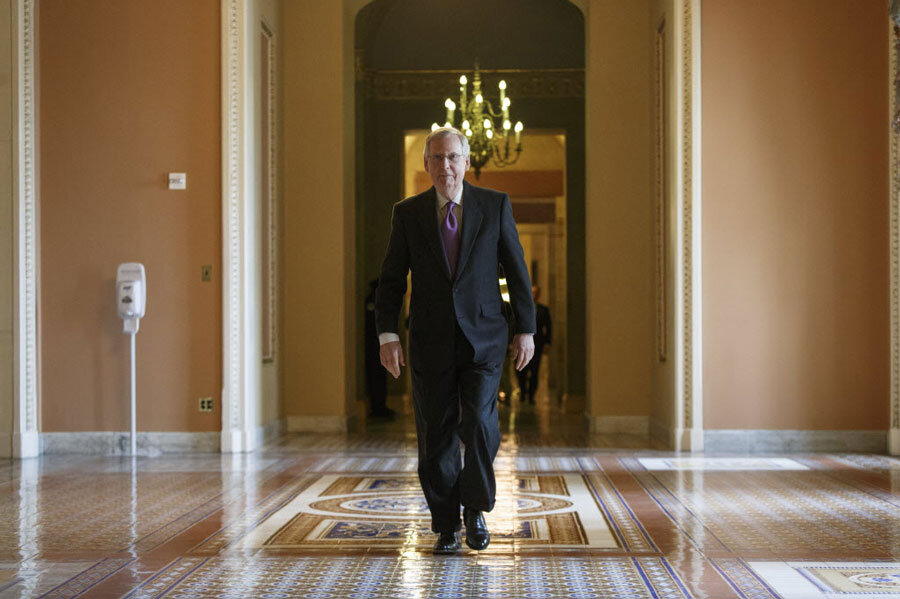Senators fight on Tuesday, lunch on Wednesday. New face of bipartisanship?
Loading...
| Washington
It’s a good thing no one struck flint in the Capitol on Tuesday. The place might have gone up in partisan flames.
House Republicans again voted to repeal the Affordable Care Act. In the Senate, Democrats and Republicans fought vigorously over immigration and homeland security funding – not what to do about these two issues, but whether to even begin debate on them.
Americans wonder: Will the partisan fighting ever stop?
That actually is the wrong question. The battling won’t end. But it can coexist with cooperation. Witness the first of a monthly series of bipartisan Senate lunches scheduled to start on Wednesday.
“We’re always going to have philosophical differences, but that doesn’t mean that we shouldn’t be able to come together and seek common ground. If you don’t talk to one another, that common ground is a lot harder to find,” says Sen. Susan Collins (R) of Maine, who is hosting the luncheon for all 100 senators with Sen. Mark Warner (D) of Virginia.
The idea is to simply have people get to know each other, and from there, perhaps build a stronger foundation for working together. The effort was spearheaded by Sens. Jeff Flake (R) of Arizona and Martin Heinrich (D) of New Mexico. In November, they suggested the idea in a letter sent to the Senate leaders that was signed by 30 of their colleagues, equally split by party.
On the agenda will be remarks by senior senators. A few freshmen also will speak. Nearly half of the senators have been in office four years or less.
“I am constantly amazed at the misinterpretations of intentions that constantly occur on both sides of the aisle, and if we’re talking to one another rather than about one another, those misinterpretations are likely to diminish,” says Senator Collins, first elected in 1996.
The first month of the new GOP Congress has gotten off to a rough start in Washington.
Presidential veto threats flew like cannon balls as Republicans in Congress moved on the Keystone pipeline, the Affordable Care Act, and blocking the president’s executive action on immigration through riders to a bill that funds the Department of Homeland Security. The department runs out of money on Feb. 27.
Republicans, meanwhile, denounced the president’s State of the Union Address, and declared his budget plan for 2016 dead on arrival. House Republicans are planning to sue over his executive action to protect millions of undocumented immigrants from deportation.
But Democrats and Republicans also have found common ground, even if not on the top tier issues. They united behind bills to prevent human trafficking and stem suicide among veterans. They passed terrorism risk insurance that had been held up in the previous Congress.
Nine Senate Democrats joined Republicans to approve the Keystone pipeline after a three-week debate. It still faces a veto, but senators on both sides said they were happy to have equal opportunity to offer amendments after that process had been bottled up under former majority leader Harry Reid (D) of Nevada.
And while the White House budget may be a nonstarter, some of the ideas in it resonate with some Republicans, such as a boost to tax credits for low-income adults and the need to repair America’s decaying infrastructure and to increase military spending.
“There’s potential to compromise behind the scenes,” says Sen. Orrin Hatch (R) of Utah, the chairman of the Senate Finance Committee. “Senator Wyden and I are working closely on trade issue, and hopefully they’ll be pretty bipartisan,” says Senator Hatch, speaking of the Democratic ranking member on the committee, Ron Wyden of Oregon.
It’s entirely possible for political leaders to throw brickbats and forge deals at the same time, politicians say.
“You’re going to have the big fights going on all the time,” says former Senate majority leader Trent Lott (R) of Mississippi.
“The question is, can you be churning out some not-as-big but important issues at the same time, and I think you’ll find that Mitch will be able to do that,” says Mr. Lott, speaking of the new Senate majority leader, Mitch McConnell (R) of Kentucky.
“These are big boys,” echoes former congressman Tom Davis, referring to the House and Senate leaders. “You can insult them one day and turn the cheek the other day and work a deal.”
The problem, Mr. Davis cautions, is not so much with the leaders, but with their followers. Conservative talk-show hosts and bloggers, outside campaign funding groups, and gerrymandered districts make for a much more confrontational political atmosphere, says Davis, coauthor of the book, “The Partisan Divide: Congress in Crisis.”
Still, when items on the Democrat and Republican to-do list line up, when deadlines or crises loom, when political circumstances create the right kind of atmosphere, then agreements can be made.
Some items – such as infrastructure, trade, and corporate tax reform – are on the lists of both the president and Republicans. Lawmakers, meanwhile, are keenly aware of approaching deadlines, whether they be the end of the month for Department of Homeland Security funding; the March deadline for the federal debt limit; or the end of May, when the Highway Trust Fund, which pays for road repair, runs out of money.
As for political circumstances, House Speaker John Boehner and Senate majority leader McConnell say they want to use their newly gained control of Congress to prove that they can govern ahead of the 2016 elections. The president, too, has his legacy to consider – though some wonder whether he has decided he can cement it without Congress.
“We’re all finding our footing right now,” trying to figure out when to cooperate and when to draw the line, Sen. Barbara Mikulski (D) of Maryland, said recently.
As lawmakers on both sides make clear, it's possible to do both.








